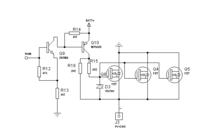naseerak
Full Member level 5
I am designing a pwm solar charge controller but having difficulty in choosing mosfets, my design is for 24v system with 42v solar pannal if I use p-channal then it is easy to measure current as the ground are common but in the case of n-channal I don,t want to use high side drivers due to complexities and cost but with simple drive I have to switch the grounds which will avoid me using current measurements any thoughts are welcome here, Presently I have IRF4905 and a lot of other n-channal power mosfets.
